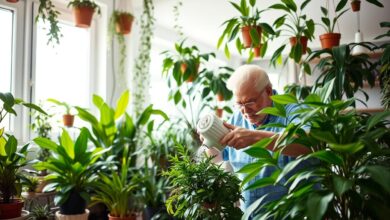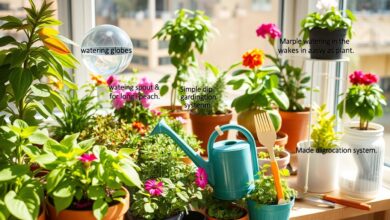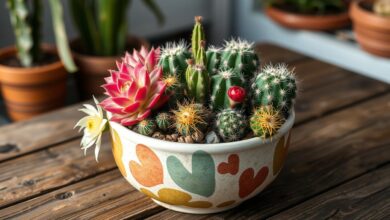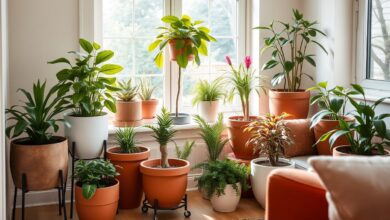Indoor Plants for Elderly Homes: Bring Nature Inside
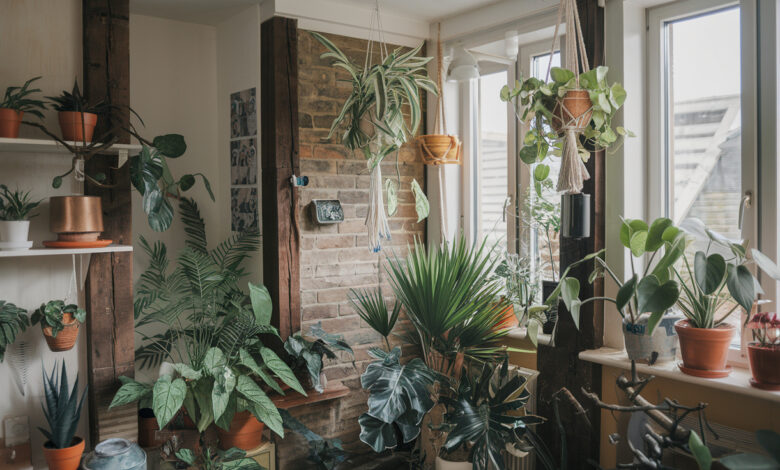
Introducing the best indoor plants for elderly homes to improve the well-being of seniors in assisted living and memory care communities. Discover the benefits of low-maintenance greenery that purifies the air, reduces stress, and fosters a calming, therapeutic environment. Whether you’re enhancing shared spaces or bringing the outdoors inside for individual residents, this guide covers a range of easy-care plants ideal for elderly homes.
From air-purifying succulents to dementia-friendly ferns, we’ll showcase the top indoor plants that thrive in senior living settings. Learn about the positive impact of therapeutic horticulture and how these natural wonders can support cognitive function, respiratory health, and overall mood. With a focus on non-toxic, scent-free plants, you can create a senior-friendly oasis that brings the healing power of nature indoors.
Table of Contents
Benefits of Indoor Plants for Elderly Homes
Indoor plants offer a multitude of benefits for the elderly residents of care facilities and assisted living homes. From improving air quality to boosting mood and reducing stress, the presence of greenery can have a profound impact on the overall well-being of senior citizens.
Air Purification and Improved Air Quality
A 1989 NASA study revealed that houseplants can effectively remove cancer-causing chemicals, such as formaldehyde and benzene, from the air. With more than 85% of our lives spent indoors, the significance of maintaining clean and healthy indoor environments cannot be overstated. By incorporating a variety of air-purifying plants, elderly homes can ensure their residents breathe in cleaner, more refreshing air.
Reduced Stress and Improved Mood
Interacting with plants, whether through physical touch or simply observing their growth, can have a calming and therapeutic effect. A 2015 study demonstrated that caring for indoor plants can reduce psychological and physiological stress, leading to a decrease in sympathetic nervous system activity and diastolic blood pressure. Additionally, exposure to indoor plants has been shown to enhance feelings of well-being, potentially improving physical health outcomes for the elderly.
Lowered Risk of Cold-Related Illnesses
Plants can provide humidity to indoor spaces, which can help alleviate winter-induced conditions such as dry skin, sore throats, and colds. The soothing aromas of certain plants, like lavender and mint, can also have a positive impact on mood and respiratory health, potentially lowering the risk of cold-related illnesses among elderly residents.
By integrating a diverse selection of indoor plants into elderly homes, caregivers can create a more calming, therapeutic, and health-promoting environment for their residents. The benefits of these natural companions extend beyond mere aesthetics, contributing to improved air quality, reduced stress, and enhanced overall well-being.
Low-Maintenance Indoor Plants for Seniors
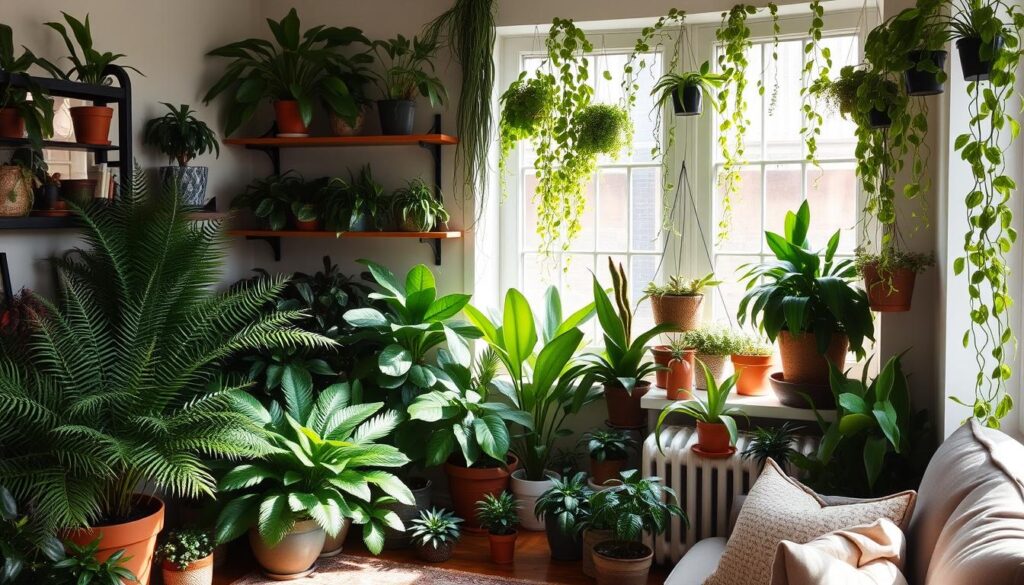
When selecting indoor plants for elderly homes, it’s crucial to choose low-maintenance options that thrive with minimal care. Succulents, such as Burro’s Tail, Jade Plant, and Aloe Vera, are excellent choices as they can withstand inconsistent watering and low-light conditions common in assisted living facilities. The Pothos plant and Chinese Evergreen (Aglaonema) are also great options, as they are resilient and adapt well to the typical indoor environment of senior living communities.
Succulents: Burro’s Tail, Jade Plant, Aloe Vera
Succulents are an ideal choice for seniors due to their hardy nature and low-maintenance requirements. Burro’s Tail, with its cascading, thick leaves, is a visually stunning succulent that requires infrequent watering. The Jade Plant, with its rounded, glossy leaves, is another succulent that thrives on neglect. Aloe Vera, known for its soothing, therapeutic properties, is easy to grow and can tolerate periods of drought.
Pothos Plant
The Pothos plant, also known as the Devil’s Ivy, is a resilient and versatile option for senior living spaces. Its trailing vines and heart-shaped leaves make it an attractive addition to any room, and its ability to adapt to a range of lighting conditions and watering schedules makes it a low-maintenance choice for elderly residents.
Chinese Evergreen (Aglaonema)
The Chinese Evergreen, or Aglaonema, is a hardy, slow-growing plant that can thrive in the low-light conditions often found in senior living facilities. Its vibrant, mottled leaves and compact growth habit make it an excellent choice for adding a touch of greenery to small spaces without requiring extensive care.
Non-Toxic Houseplants for Senior Living
When it comes to decorating elderly homes or senior living facilities, safety should be the top priority. Fortunately, there are several non-toxic indoor plants that can thrive in these spaces without posing any health risks. Three excellent options are the Christmas Cactus, Boston Fern, and Parlor Palm.
Christmas Cactus
The cheerful Christmas Cactus is a non-toxic houseplant that can add a festive touch to senior-friendly environments. This low-maintenance plant requires moderate watering and partial shade, making it an ideal choice for senior-friendly houseplants.
Boston Fern
The lush and graceful Boston Fern is another excellent option for dementia-friendly gardens and memory care landscaping. These ferns thrive in humid, low-light conditions, making them well-suited for the typical indoor environment of assisted living facilities.
Parlor Palm
The elegant Parlor Palm is a non-toxic, low-maintenance plant that can enhance the ambiance of assisted living decor. This palm variety requires minimal watering and can tolerate a range of light conditions, making it an excellent choice for senior-friendly houseplants.
By incorporating these non-toxic indoor plants into elderly homes and senior living spaces, you can bring the calming benefits of nature while ensuring the safety and well-being of the residents.
Scent-Free Flowering Plants
For elderly residents who may be sensitive to strong scents, there are several beautiful, scent-free flowers that can be incorporated into the living space. These non-fragrant plants offer a touch of natural beauty without overwhelming the senses, making them perfect for senior-friendly decor in assisted living and memory care environments.
Sunflowers
Sunflowers are a vibrant, low-maintenance option that can add a cheerful pop of color to any room. These scent-free flowers are easy to care for and can thrive in various lighting conditions, making them an ideal choice for indoor gardening in elderly homes.
Dahlias
Dahlias are another stunning, non-fragrant plant that can bring a touch of elegance to senior living spaces. With their wide range of colors and shapes, Dahlias can be used to create beautiful floral arrangements or as standalone accents in memory care landscaping.
Hibiscus
The vibrant, tropical-inspired blooms of Hibiscus make them a beautiful addition to any senior-friendly decor. These scent-free flowers are low-maintenance and can thrive indoors, providing a cheerful and calming presence in assisted living environments.
By incorporating these scent-free flowers into the living space, seniors can enjoy the beauty of nature without being overwhelmed by strong fragrances. These non-fragrant plants are perfect for creating a serene and senior-friendly decor in assisted living and memory care settings.
Air-Purifying Indoor Plants
When it comes to enhancing indoor air quality in senior living communities, air-purifying houseplants can be a game-changer. These natural air filters are not only aesthetically pleasing but also highly effective in removing harmful toxins and pollutants, making them a valuable addition to any memory care or therapeutic horticulture program.
Snake Plant (Sansevieria)
The Snake Plant, also known as Sansevieria, is a versatile and resilient indoor plant that stands out for its remarkable air-purifying capabilities. In a landmark 1989 study by NASA scientist Bill Wolverton, the Snake Plant was identified as one of the most efficient plants at removing harmful chemicals, such as benzene and formaldehyde, from the air. Its ability to convert carbon dioxide into oxygen during the night makes it an excellent choice for senior living spaces, where improved respiratory health can make a significant difference.
Swiss Cheese Plant (Monstera Deliciosa)
Another exceptional air-purifying indoor plant for senior living is the Swiss Cheese Plant, also known as Monstera Deliciosa. This lush, tropical-looking plant is a natural at absorbing airborne toxins, including benzene and trichloroethylene, which are commonly found in indoor environments. The Swiss Cheese Plant’s large, perforated leaves not only enhance its air-purifying properties but also add a visually striking element to any space, making it an ideal choice for memory care gardening or therapeutic horticulture programs.
By incorporating these air-purifying houseplants into senior living communities, facility managers can create a healthier, more rejuvenating indoor environment for residents, potentially improving their respiratory health, reducing stress, and enhancing their overall well-being.
Indoor Plants for Elderly Homes
When creating a soothing and rejuvenating environment for the elderly, indoor plants can play a vital role. Two such plants that thrive in senior living spaces are the Peace Lily and the Spider Plant.
Peace Lily
The Peace Lily is an exceptional air-purifying plant, renowned for its ability to remove harmful toxins and vapors from the air. This makes it an excellent choice for the indoor environments often found in elderly homes. Not only does the Peace Lily help improve air quality, but its beautiful, delicate white flowers can also have a calming effect, promoting a sense of serenity.
Spider Plant
Another low-maintenance option for elderly homes is the Spider Plant. This versatile plant is known for its air-purifying properties, effectively removing toxins such as carbon monoxide and formaldehyde. The Spider Plant’s cascading, graceful leaves create a visually appealing addition to any indoor space, making it a popular choice for senior living facilities.
Both the Peace Lily and the Spider Plant are relatively easy to care for, requiring minimal effort from busy caregivers or residents. Their resilience and adaptability make them ideal selections for the senior living community, where low-maintenance plants can thrive and provide a connection to nature.
Therapeutic Houseplants for Seniors
As seniors often spend more time indoors, introducing therapeutic houseplants can be a wonderful addition to their living spaces. One such plant that shines in this regard is the aloe vera. This versatile succulent is packed with antioxidants and antibacterial properties, making it a valuable natural remedy for a variety of common issues faced by the elderly.
The soothing gel of the aloe vera plant can be extracted and applied topically, providing relief for minor skin irritations, sunburns, and other ailments. This makes it an ideal choice for seniors in assisted living facilities who may require gentle, natural solutions for their health concerns. Studies have shown that aloe vera can reduce cold-related illnesses by more than 30%, making it a valuable asset for maintaining senior well-being during the colder months.
Beyond its therapeutic benefits, the aloe vera plant is also relatively low-maintenance, making it a suitable choice for seniors new to indoor gardening. Its hardy nature and easy care requirements ensure that even those with limited experience can successfully cultivate this remarkable houseplant and enjoy its numerous advantages.
Incorporating aloe vera and other therapeutic houseplants into the living spaces of seniors can have a profoundly positive impact on their overall health and well-being. By providing natural remedies, improving air quality, and fostering a soothing, natural environment, these plants can become valuable assets in the pursuit of holistic care for the elderly population.
Cognitive-Enhancing Plants
When it comes to creating a dementia-friendly garden or memory care landscaping, the ZZ plant stands out as a remarkable indoor option. Not only does this air-purifying plant help improve air quality, but emerging research also suggests it may have cognitive-enhancing effects, making it a valuable addition to senior living environments.
The ZZ plant, also known as the Zamioculcas zamiifolia, has therapeutic and antioxidant properties that may help improve cognitive function, including learning, reasoning, and attention. This makes the ZZ plant an excellent choice for seniors, particularly those experiencing cognitive decline or living with dementia.
In a systematic review of 81 studies, researchers found that exposure to natural environments, both indoor and outdoor, can have a positive impact on human well-being. The review, which included 9 primary studies, highlighted the mental health benefits of incorporating greenery into living spaces.
Furthermore, a study conducted by researchers at Texas A&M University discovered that the presence of plants can reduce anxiety, promote healing, and improve mood, which is especially valuable for seniors facing psychological distress, such as depression.
The ZZ plant’s ability to thrive in low-light conditions and its resilience to neglect make it an ideal choice for senior living environments. Its air-purifying properties, combined with its potential cognitive-enhancing benefits, make the ZZ plant a must-have for any dementia-friendly garden or memory care landscaping project.
Plants for Respiratory Health
As seniors spend more time indoors, ensuring a clean and healthy indoor environment becomes crucial. One solution lies in the power of English ivy, an exceptional indoor plant choice for elderly residents. This hardy and adaptable plant has been found to be highly effective in treating respiratory conditions like asthma, bronchitis, and COPD.
The therapeutic properties of English ivy can help reduce inflammation and improve breathing, making it a beneficial addition to senior living spaces, especially for those with respiratory issues. Clemson University Cooperative Extension research has shown that English ivy can lower levels of carbon dioxide, formaldehyde, and other toxins in indoor air, creating a healthier environment for seniors.
Beyond its air-purifying abilities, English ivy is also a low-maintenance plant, making it an ideal choice for elderly residents who may have limited mobility or gardening experience. With its trailing vines and lush foliage, English ivy can add a touch of nature and calmness to any indoor space, potentially contributing to a more relaxed and rejuvenating atmosphere for senior residents.
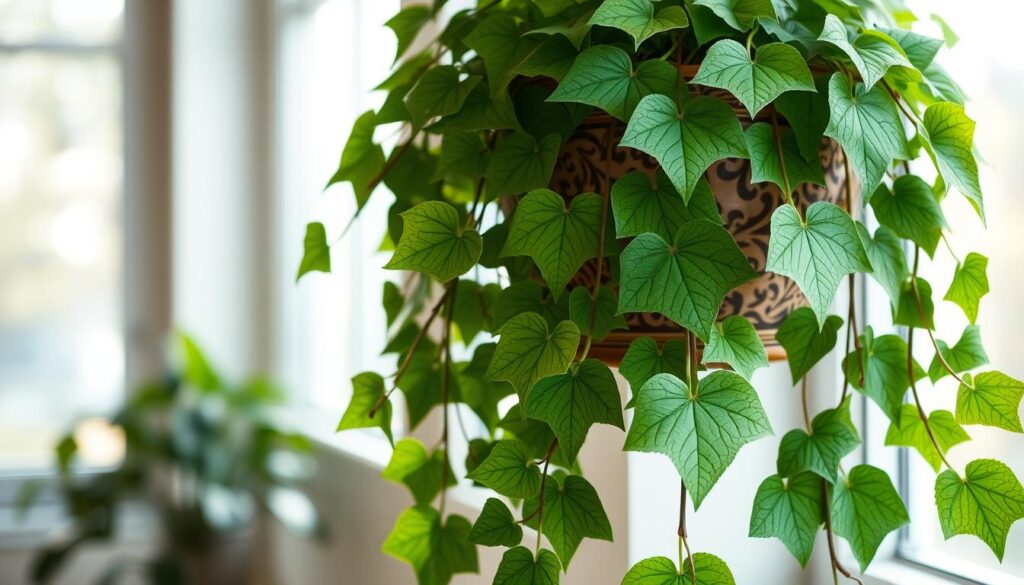
By incorporating English ivy and other air-purifying plants into their living spaces, seniors can benefit from improved respiratory health, reduced stress, and a more vibrant, nature-inspired environment. This simple addition to senior living communities can have a profound impact on the well-being and quality of life for elderly residents.
Odor-Eliminating Houseplants
Maintaining a fresh, inviting atmosphere is crucial in senior living environments. The Golden Pothos, a resilient indoor plant, can be a valuable asset in eliminating unpleasant odors and purifying the air for elderly residents.
In addition to its impressive air-purifying abilities, which help remove harmful toxins like formaldehyde and benzene, the Golden Pothos can also neutralize various undesirable smells. By effectively filtering out these odor-causing compounds, this versatile plant can contribute to a cleaner, more comfortable living space for seniors.
Golden Pothos
The Golden Pothos is a low-maintenance and fast-growing houseplant that thrives in a variety of indoor conditions. Its lush, trailing vines and heart-shaped leaves make it an attractive addition to any room, while its remarkable air-purifying properties make it particularly well-suited for assisted living facilities and senior care homes.
- Efficiently removes formaldehyde, carbon monoxide, and benzene from the air
- Helps neutralize unpleasant odors, creating a fresher, more inviting atmosphere
- Easy to care for, requiring minimal watering and maintenance
- Adaptable to different lighting conditions, making it a versatile choice
- Visually appealing, with its vibrant green foliage and trailing vines
By incorporating the Golden Pothos and other odor-eliminating houseplants into senior living spaces, facility managers and caregivers can enhance the overall air quality and create a more comfortable, welcoming environment for their elderly residents.
Allergy-Reducing Indoor Plants
For seniors living in assisted living facilities or at home, indoor plants can offer a natural solution to combat allergens and improve air quality. One standout option is the Rubber Plant, also known as the Ficus Elastica. This resilient and low-maintenance plant has been shown to possess anti-inflammatory properties, making it an excellent choice for those prone to respiratory sensitivities or allergic reactions.
A study conducted by NASA in 1989 found that the Rubber Plant, along with other members of the Dracaena family, can effectively filter out common indoor air pollutants such as cigarette smoke, benzene, and formaldehyde. This ability to purify the air makes the Rubber Plant a valuable addition to any senior living space, helping to reduce the prevalence of allergens and create a healthier indoor environment.
In addition to its air-purifying capabilities, the Rubber Plant is also known for its low-maintenance nature, making it an ideal choice for seniors who may have limited time or physical abilities to care for more high-maintenance plants. With its large, glossy leaves and sturdy, upright growth habit, the Rubber Plant can thrive in a variety of indoor lighting conditions, making it a versatile and reliable option for senior living spaces.
When selecting indoor plants to help reduce allergens, it’s important to consider factors such as pollen production, mold growth, and the potential for triggering sensitivities. By choosing allergy-friendly plants like the Rubber Plant, seniors can enjoy the benefits of nature indoors while minimizing the risk of allergic reactions.
Key Allergy-Reducing Indoor Plants for Seniors
- Rubber Plant (Ficus Elastica)
- Golden Pothos
- Philodendron Brasil
- Parlor Palm
- Dragon Tree
- Peace Lily
- Mother-In-Law’s Tongue (Snake Plant)
| Plant | Allergy-Reducing Benefits |
|---|---|
| Rubber Plant (Ficus Elastica) | Effective at removing formaldehyde, benzene, and other indoor air pollutants |
| Golden Pothos | Removes formaldehyde, benzene, and other toxins from indoor air |
| Philodendron Brasil | Specifically effective at removing formaldehyde from indoor environments |
| Parlor Palm | Absorbs and filters out a variety of airborne toxins, improving air quality |
| Dragon Tree | Can remove formaldehyde, xylene, and toluene from indoor air |
| Peace Lily | Absorbs mold spores and prevents their growth, ideal for humid spaces |
| Mother-In-Law’s Tongue (Snake Plant) | Effectively removes formaldehyde, benzene, and xylene from indoor air |
Tips for Caring for Indoor Plants
Introducing indoor plants to an elderly home or assisted living facility can be a wonderful way to bring nature inside and provide a range of benefits to residents. However, proper care and maintenance are essential to ensure the plants thrive and continue to enhance the living environment. By following these simple tips, senior living communities can cultivate a lush, low-maintenance indoor garden that seniors can enjoy.
Select Low-Maintenance Varieties
When choosing indoor plants for senior living, opt for low-maintenance varieties that require minimal effort to care for. Some excellent options include succulents, pothos, Chinese Evergreen, and snake plants. These plants can tolerate occasional missed waterings and fluctuations in light levels, making them ideal for senior-friendly indoor gardening.
Provide Appropriate Lighting and Water
Proper lighting and watering are critical for the health and longevity of indoor plants. Ensure each plant is placed in a location that receives the appropriate amount of sunlight, as some thrive in bright, direct light while others prefer indirect or low-light conditions. Similarly, establish a consistent watering schedule, taking care not to over-water or underwater the plants.
Monitor and Maintain Plant Health
Regularly inspect your indoor plants for any signs of pests, disease, or stress. Promptly address any issues to prevent the problem from worsening and potentially affecting other plants. Gentle pruning, occasional repotting, and the use of specialized plant foods can also help keep your indoor garden thriving.
By following these tips for caring indoor plants, senior living communities can enjoy the many benefits of low-maintenance greenery and create a welcoming, nature-inspired atmosphere for their residents. With a little bit of care and attention, these indoor plants can thrive and contribute to the overall well-being and comfort of the assisted living environment.
Creative Indoor Gardening Ideas
For seniors living in assisted living or memory care facilities, bringing the outdoors in can be a wonderful way to connect with nature and boost mood and well-being. Beyond traditional potted plants, there are many creative indoor gardening ideas that can add visual interest and a touch of greenery to senior living spaces.
Hanging baskets and terrariums are two popular options that require minimal care and can be easily maintained by older adults. These self-contained ecosystems not only look beautiful, but also help purify the air and provide a soothing focal point. Indoor vertical gardens, where plants are grown upright on a wall or frame, are another innovative solution that conserves floor space while bringing the outdoors in.
For seniors who enjoy a bit of hands-on activity, plant pot painting can be a fun and therapeutic craft. Decorating their own plant containers allows residents to express their creativity while reinforcing fine motor skills. Socializing during these gardening activities can also provide cognitive and emotional benefits.
Another idea is to create a mini indoor herb garden on a windowsill or countertop. Herbs like thyme, mint, basil, and chives not only offer a pleasant aroma, but can also be used in cooking, helping seniors feel more independent and engaged in daily tasks.
By incorporating these creative indoor gardening ideas, senior living communities can foster a connection to nature, reduce stress, and enhance the overall quality of life for their residents.
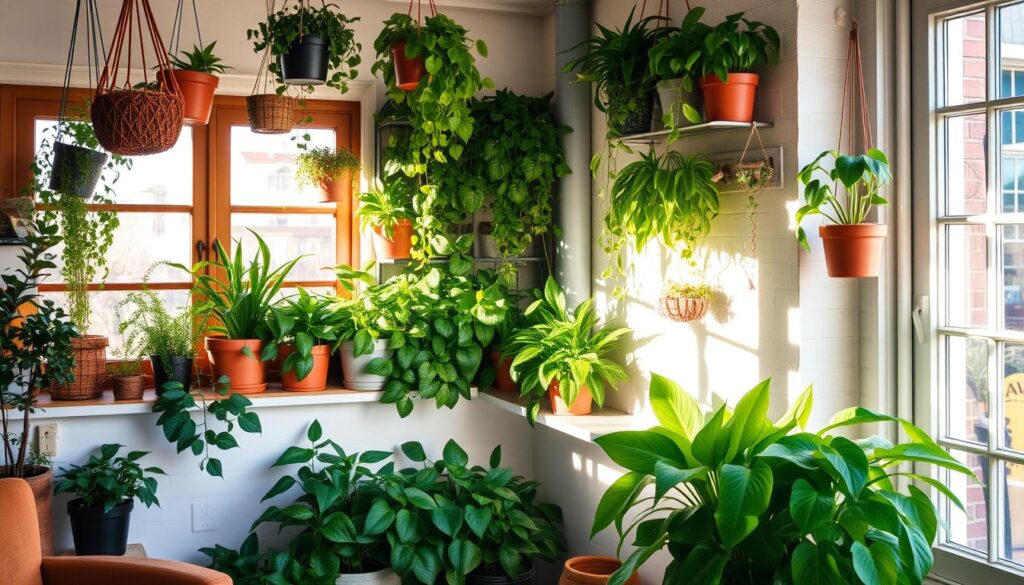
| Indoor Gardening Ideas | Benefits for Seniors |
|---|---|
| Hanging Baskets | Require minimal care, help purify air, provide visual interest |
| Terrariums | Self-contained ecosystems, low-maintenance, boost mood |
| Indoor Vertical Gardens | Conserve floor space, bring nature indoors |
| Plant Pot Painting | Therapeutic craft, reinforce fine motor skills, promote socialization |
| Mini Indoor Herb Garden | Provide fresh herbs for cooking, boost independence |
Outdoor Garden Alternatives
For elderly residents in assisted living, memory care, or senior living communities, maintaining an outdoor garden may not always be feasible. However, that doesn’t mean seniors have to forgo the therapeutic benefits of interacting with nature. There are various outdoor garden alternatives that can bring the joy of gardening indoors, catering to the unique needs and preferences of the senior population.
One popular option is growing herbs on a windowsill. Herbs like mint, basil, parsley, and rosemary not only provide a convenient source of fresh ingredients for cooking but also offer a pleasant aroma that can evoke memories and reduce stress. Seniors with limited mobility can easily tend to these compact, low-maintenance plants without the physical demands of a traditional outdoor garden.
Another alternative is creating a small indoor vegetable garden. Containers, grow towers, or even fabric bags can be used to cultivate crops like lettuce, tomatoes, carrots, and peppers, allowing seniors to enjoy the satisfaction of growing their own produce. These low-maintenance greenery solutions can be tailored to the specific needs and abilities of each individual, fostering a sense of purpose and engagement.
For those seeking a more immersive indoor gardening experience, a mini-greenhouse can be a delightful solution. These compact, self-contained units enable seniors to cultivate a variety of plants, including delicate flowers like geraniums, petunias, lavender, and marigolds, without the challenges of maintaining a full-scale outdoor garden.
By incorporating these outdoor garden alternatives into senior living, assisted living, and memory care facilities, the benefits of nature can be brought indoors, providing seniors with a sense of purpose, mental stimulation, and improved overall well-being.
Conclusion
Incorporating indoor plants into elderly homes and senior living facilities can have a transformative impact on the well-being and quality of life for residents. From improving air quality and reducing stress to providing cognitive stimulation and therapeutic benefits, the right indoor plants can create a more vibrant, nature-infused environment that caters to the unique needs and preferences of seniors. By carefully selecting low-maintenance, non-toxic, and air-purifying varieties, caregivers can help elderly residents enjoy the beauty and therapeutic power of indoor greenery.
Research has shown that working with indoor plants can lower stress levels, improve concentration, and boost productivity and creativity. Horticultural therapy has also been used to increase well-being in individuals with depression, anxiety, and dementia. Furthermore, certain indoor plants have been identified as effective at purifying the air and reducing volatile organic compounds (VOCs), which can improve respiratory health.
As seniors face unique challenges related to aging, incorporating indoor plants into their living spaces can provide a multitude of benefits. From the air-purifying qualities of the Snake Plant and Swiss Cheese Plant to the therapeutic effects of Aloe Vera and the cognitive-enhancing properties of the ZZ Plant, the right indoor plants can create a more comfortable, rejuvenating, and enriching environment for elderly residents. By embracing the power of indoor gardening, caregivers can support the overall well-being and quality of life for seniors in their care.
FAQ
What are the benefits of indoor plants for elderly homes?
Indoor plants can provide numerous benefits for elderly residents, including air purification, improved indoor air quality, reduced stress, improved mood, and a lowered risk of cold-related illnesses. The presence of greenery can also have a calming and therapeutic effect, promoting overall well-being for seniors.
What are some low-maintenance indoor plants suitable for senior living?
Succulents like Burro’s Tail, Jade Plant, and Aloe Vera are excellent low-maintenance options for elderly homes, as they can withstand inconsistent watering and low-light conditions. The Pothos plant and Chinese Evergreen (Aglaonema) are also great choices, as they are resilient and adapt well to typical indoor environments.
What non-toxic houseplants are safe for seniors and their pets?
The Christmas Cactus, Boston Fern, and Parlor Palm are all excellent non-toxic options that can thrive in senior living facilities without posing a health risk to residents or their pets.
What scent-free flowering plants are suitable for elderly homes?
Sunflowers, Dahlias, and Hibiscus are vibrant, low-maintenance, and scent-free flowering plants that can add a touch of natural beauty to senior living environments without overwhelming the senses.
What air-purifying indoor plants are beneficial for elderly residents?
The Snake Plant (Sansevieria) and Swiss Cheese Plant (Monstera Deliciosa) are excellent air-purifying options that can efficiently absorb carbon dioxide and release oxygen, while also filtering out common indoor pollutants.
What other indoor plants can provide therapeutic benefits for seniors?
Aloe Vera is a versatile and therapeutic plant that can be used to treat minor skin irritations and other common issues. The ZZ Plant has also been found to have cognitive-enhancing effects, which can be particularly beneficial for elderly residents, especially those with dementia or cognitive decline.
How can indoor plants help with respiratory health for seniors?
English Ivy has been found to be effective in treating respiratory conditions like asthma, bronchitis, and COPD, making it a beneficial addition to senior living spaces. The Rubber Plant (Ficus Elastica) can also help reduce the prevalence of allergies by filtering out common allergens.
How can indoor plants help eliminate odors in senior living environments?
The Golden Pothos is a versatile indoor plant that can help eliminate unpleasant odors by removing toxins like formaldehyde and benzene from the air, creating a fresher, more inviting atmosphere for elderly residents.
What are some tips for caring for indoor plants in elderly homes?
When introducing indoor plants to an elderly home or senior living facility, it’s important to select low-maintenance varieties, provide the appropriate amount of sunlight and water, and regularly monitor the plants for any issues. Following these simple care tips can help seniors enjoy the benefits of indoor greenery without the burden of high-maintenance requirements.
What are some creative ways to incorporate indoor gardening in senior living spaces?
Ideas like hanging baskets, terrariums, and indoor vertical gardens can add visual interest and a touch of nature to elderly living spaces, while requiring minimal care. Growing herbs on a windowsill or maintaining a small indoor vegetable garden are also great alternatives that can provide a similar sense of purpose and engagement for seniors.

